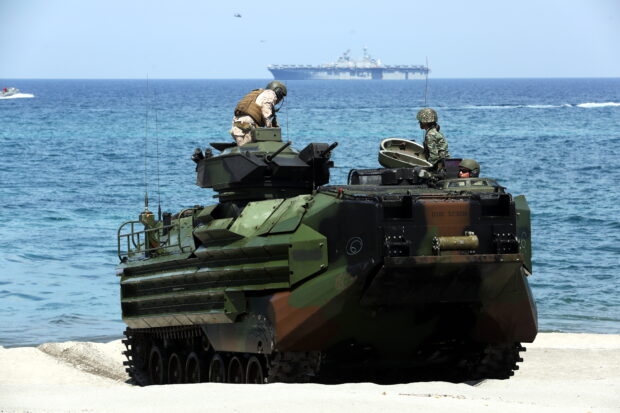
MILITARY DRILLS | In this photo taken in April 2019, Filipino and American troops storm a beach facing the West Philippine Sea in Zambales province during amphibious exercises as part of that year’s “Balikatan” military exercise. Zambales will again host the troops for this year’s drills. (Photo by NIÑO JESUS ORBETA / Philippine Daily Inquirer)
SAN ANTONIO, Zambales, Philippines — During the peak fishing season between February and May, residents in the coastal villages of this Zambales town would enjoy a bountiful catch of fish, squid, and other seafood.
But on Monday, they expressed fear that their catch might dwindle drastically because of the biggest war games between the Philippines and the United States that will begin today as a large portion of the town’s usual fishing ground would be a “no-sail zone” on some days of the 18-day exercise.
A number of the major “Balikatan” (shoulder-to-shoulder) drills previously scheduled in Ilocos Norte were also moved to Zambales, where five localities, including this town, will host live-fire drills to test the newly acquired weapons systems of the two allies.
Among these is the sinking of a 200-foot decommissioned fishing vessel serving as a mock enemy ship at the Naval Education, Training and Doctrine Command (NETDC) in this town facing the West Philippine Sea.
Fish vendor Mylene Agapin, 60, told the Inquirer that she was worried that local fishing areas would be disturbed during the Balikatan and that her fisherman-husband might not be able to take home anything.
“From February to May, we could earn P4,000 on each fishing trip. So, we take advantage of the time because there is nothing to catch from June to August,” she pointed out, urging the government to stage the Balikatan during the lean season.
“How are we going to make a living if there is nothing to catch?” Agapin asked.
Environmental risk
Hilda Reyes, president of the association of fisherfolk and fish traders in the villages of San Miguel and Pundaquit, said fishermen who ventured out to sea on Monday went home empty-handed.
“As of now, it’s hard to catch fish because US and Philippine Navy ships are already here,” she said, noting that fishermen in Sta. Cruz town, about 125 kilometers north of San Antonio, are still enjoying a big catch.
On March 9, the Philippine Coast Guard (PCG) notified its local substation in this province that the waters off NETDC had been declared a “no-sail zone” from April 25 to 27.
SN1 Mar Azheron Marasigan, commander of the PCG substation in Botolan town, confirmed on Monday that all vessels transiting the waters between San Antonio and Botolan were prohibited from sailing during that period when actual live-firing exercises are expected to be staged as part of the Balikatan.
According to Bobby Roldan, a fisherman in Masinloc town, they were “legitimately concerned” about the military exercise, particularly in Zambales since the war games would definitely affect their livelihood.
“[The military training] is also dangerous for coral reefs because warships can run aground and hit them, just like what happened to the Tubbataha Reef in Palawan a decade ago,” said Roldan, who is also vice chair for Luzon of the fisherfolk group Pamalakaya.
He said the group had been asking the Marcos administration to seriously consider the fishermen’s concerns related to the Balikatan.
“It (Balikatan) should be stopped or carried out in other areas where the livelihood and security of the inhabitants will not be compromised,” Roldan said.
Consultation with LGUs
The Armed Forces of the Philippines, however, on Monday sought to allay concerns about the livelihood of fishermen getting disrupted due to the scheduled live-fire drills.
“The exercises are coordinated with the host local government units (LGUs), including all issues and concerns,” AFP spokesperson Col. Medel Aguilar told the Inquirer.
The provincial government also usually advises its coastal towns and cities during such events to take precautionary measures for their safety.
More than 17,000 troops—12,000 from the United States, 5,000 from the Philippines and about 100 from Australia—will participate in this year’s military exercise.
US military ships and aircraft started to arrive in the Philippines last week to transport personnel and equipment for the Balikatan drills. The latest to come in was the US Navy amphibious transport dock USS Anchorage that pulled into the Subic Bay port on Monday.
A US Air Force C-130J transport aircraft and a Royal Australian Air Force C-17 landed in Palawan last week for humanitarian and civic assistance projects and special operations forces training, according to the Philippine Air Force.
In Congress, House Deputy Minority Leader France Castro on Monday opposed the country’s participation in the joint military drills, arguing that the Philippines should not take part in the Balikatan to avoid getting caught in the middle of tensions between the United States and China.
For Castro, the AFP should instead focus its efforts on guarding against intrusions into the country’s territory, such as the West Philippine Sea.
The Balikatan is the most prominent large-scale exercise between the Philippine and American militaries to enhance their cooperation and interoperability under the Visiting Forces Agreement signed by the two countries in 1998.

